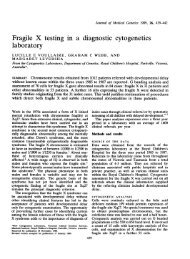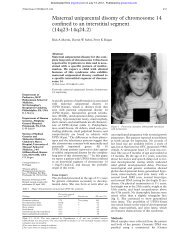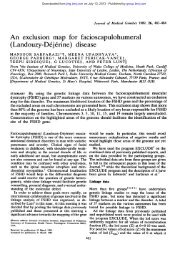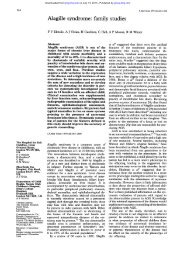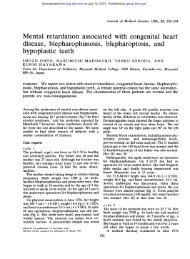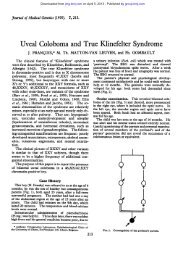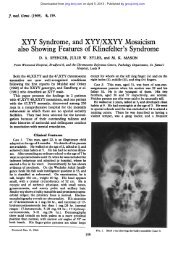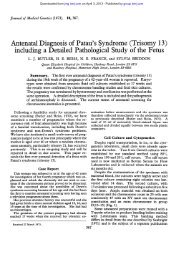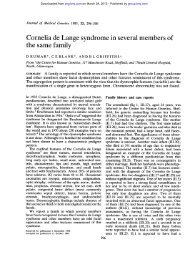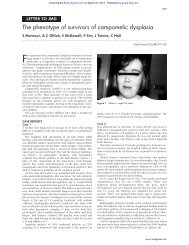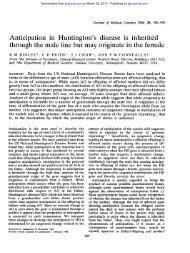Pre-eclampsia/eclampsia in twin pregnancies - Journal of Medical ...
Pre-eclampsia/eclampsia in twin pregnancies - Journal of Medical ...
Pre-eclampsia/eclampsia in twin pregnancies - Journal of Medical ...
Create successful ePaper yourself
Turn your PDF publications into a flip-book with our unique Google optimized e-Paper software.
<strong>Journal</strong> <strong>of</strong> <strong>Medical</strong> Genetics (1976). 13, 208-211.<br />
<strong>Pre</strong>-<strong>eclampsia</strong>/<strong>eclampsia</strong> <strong>in</strong> tw<strong>in</strong> <strong>pregnancies</strong><br />
A. McFARLANE and J. S. SCOTT<br />
From the Department <strong>of</strong> Obstetrics and Gynaecology (Leeds Maternity Hospital), University <strong>of</strong> Leeds, 17 Spr<strong>in</strong>gfield<br />
Mount, Leeds LS2 9NG<br />
Summary. A study <strong>of</strong> 1045 tw<strong>in</strong> gestations with regard to known or likely<br />
zygosity and the <strong>in</strong>cidence <strong>of</strong> pre-<strong>eclampsia</strong>/<strong>eclampsia</strong> failed to reveal differences<br />
between known dizygous tw<strong>in</strong>s and like-sex 'presumed' and 'estimated' monozygous<br />
tw<strong>in</strong>s except <strong>in</strong> the 'estimated' data for multigravidae. There was a threefold <strong>in</strong>crease<br />
<strong>in</strong> the <strong>in</strong>cidence for tw<strong>in</strong>s as opposed to s<strong>in</strong>gleton <strong>pregnancies</strong>. These results<br />
are discussed <strong>in</strong> relation to <strong>in</strong>creased conceptus-mother antigenic differences. It is<br />
suggested that the risk <strong>of</strong> gestosis <strong>in</strong> tw<strong>in</strong> pregnancy <strong>in</strong>volves more than a summation<br />
<strong>of</strong> that operat<strong>in</strong>g <strong>in</strong> two s<strong>in</strong>gleton <strong>pregnancies</strong>.<br />
It has been suggested that genetic <strong>in</strong>compatibility<br />
between mother and fetus may be a factor <strong>in</strong> the<br />
aetiology <strong>of</strong> pre-<strong>eclampsia</strong> (Penrose, 1946; Kalmus,<br />
1946; Platt, Stewart, and Emery, 1958). Epidemiological<br />
evidence has been provided by Stevenson et<br />
al (1971) <strong>in</strong> a study <strong>of</strong> consangu<strong>in</strong>eous marriages <strong>in</strong><br />
the Middle East. They also recorded tw<strong>in</strong> data<br />
which po<strong>in</strong>ted to a higher <strong>in</strong>cidence <strong>of</strong> toxaemia <strong>in</strong><br />
unlike-sex as opposed to like-sex tw<strong>in</strong> <strong>pregnancies</strong>.<br />
As all unlike-sex tw<strong>in</strong>s are dizygous (DZ) and a large<br />
proportion <strong>of</strong> like-sex tw<strong>in</strong>s are monozygous (MZ),<br />
antigenic differences between mother and conceptus<br />
would be more likely to be expressed <strong>in</strong> unlike-sex<br />
tw<strong>in</strong> <strong>pregnancies</strong>. Stevenson et al considered that<br />
the higher <strong>in</strong>cidence with unlike-sex tw<strong>in</strong>s could be<br />
attributed to this. They extrapolated their data on<br />
the basis <strong>of</strong> We<strong>in</strong>berg's hypothesis <strong>in</strong>volv<strong>in</strong>g the<br />
assumption that for every pair <strong>of</strong> unlike-sex DZ<br />
tw<strong>in</strong>s there is one like-sex DZ pair. The estimated<br />
differences <strong>in</strong> the <strong>in</strong>cidence <strong>of</strong> pre-<strong>eclampsia</strong> based<br />
on this were significant at P values <strong>of</strong>
Downloaded from<br />
jmg.bmj.com on July 13, 2013 - Published by group.bmj.com<br />
(c) 'Estimated' MZ-total like-sex tw<strong>in</strong>s less number<br />
<strong>of</strong> unlike-sex tw<strong>in</strong>s (We<strong>in</strong>berg's differential method).<br />
To calculate the likely <strong>in</strong>cidence <strong>of</strong> various categories<br />
<strong>of</strong> hypertensive disease under 'estimated' MZ, the number<br />
occurr<strong>in</strong>g <strong>in</strong> the certa<strong>in</strong>ly DZ category was subtracted<br />
from that <strong>in</strong> like-sex tw<strong>in</strong>s.<br />
D. S<strong>in</strong>gleton comparison<br />
To compare the <strong>in</strong>cidence <strong>of</strong> pre-<strong>eclampsia</strong> <strong>in</strong> tw<strong>in</strong> and<br />
s<strong>in</strong>gleton <strong>pregnancies</strong> a matched-pair comparison was<br />
done. Tw<strong>in</strong> records from every third year were matched<br />
aga<strong>in</strong>st the next appropriate s<strong>in</strong>gleton record, exclud<strong>in</strong>g<br />
anencephalics. Match<strong>in</strong>g covered the follow<strong>in</strong>g particulars:<br />
(a) Age-to with<strong>in</strong> 5 years.<br />
(b) Parity-primigravidae, previous abortions only,<br />
multiparae, grande multiparae (5 or more previous deliveries).<br />
(c) Gestation length-30 weeks or less, 31 to 35 weeks,<br />
36 weeks or more.<br />
(d) Sex <strong>of</strong> child-<strong>in</strong> the case <strong>of</strong> unlike-sex tw<strong>in</strong>s alternate<br />
male and female s<strong>in</strong>gletons were taken.<br />
Results<br />
The results <strong>of</strong> the comparative analyses on different<br />
forms <strong>of</strong> hypertension and the different categories<br />
<strong>of</strong> tw<strong>in</strong> <strong>pregnancies</strong> are shown <strong>in</strong> Table I.<br />
<strong>Pre</strong>-<strong>eclampsia</strong>/<strong>eclampsia</strong> <strong>in</strong> tw<strong>in</strong> <strong>pregnancies</strong><br />
None <strong>of</strong> the observed values <strong>in</strong>dicates a significant<br />
difference between the 'certa<strong>in</strong>ly DZ' tw<strong>in</strong>s and<br />
other groups <strong>in</strong> relation to pre-<strong>eclampsia</strong>/<strong>eclampsia</strong><br />
<strong>in</strong>cidence. The 'estimated MZ' values give a lower<br />
figure for multiparae significant at the 5% level but<br />
<strong>in</strong> primigravidae the difference is reversed and when<br />
primigravidae and multigravidae are considered together<br />
there is no significant difference. Table II<br />
gives the details <strong>of</strong> the matched pair comparison<br />
between tw<strong>in</strong>s and s<strong>in</strong>gletons, <strong>in</strong>dicat<strong>in</strong>g an approximate<br />
threefold <strong>in</strong>crease <strong>in</strong> <strong>in</strong>cidence <strong>of</strong> pre-<strong>eclampsia</strong>/<strong>eclampsia</strong><br />
<strong>in</strong> tw<strong>in</strong> as opposed to s<strong>in</strong>gleton <strong>pregnancies</strong>.<br />
Discussion<br />
With the exception <strong>of</strong> the data on 'estimated' MZ<br />
multiparous tw<strong>in</strong> <strong>pregnancies</strong>, these results suggest<br />
there is no difference <strong>in</strong> the <strong>in</strong>cidence <strong>of</strong> pre<strong>eclampsia</strong>/eclampsai<br />
between DZ and MZ <strong>pregnancies</strong><br />
<strong>in</strong> this population. The exception was ma<strong>in</strong>ly<br />
contributed to by cases <strong>of</strong> mild pre-<strong>eclampsia</strong> and,<br />
as Adams and MacGillivray (1961) have po<strong>in</strong>ted out,<br />
some such cases may not have true pre-<strong>eclampsia</strong>.<br />
Furthermore, <strong>in</strong> multiparous patients the diagnosis<br />
<strong>of</strong> pre-<strong>eclampsia</strong> is less accurate than <strong>in</strong> primigravidae.<br />
McCartney (1964), for example, us<strong>in</strong>g renal<br />
TABLE I<br />
INCIDENCE OF HYPERTENSIVE DISEASE AND TWIN CATEGORY<br />
Category Categry<br />
<strong>of</strong>oTwi Tw<strong>in</strong> <strong>Pre</strong>nancy <strong>Pre</strong>gnancy No. <strong>of</strong>f Caes Cases Mild <strong>Pre</strong>- Severe ecldmPsia <strong>Pre</strong>_ Total <strong>Pre</strong><strong>eclampsia</strong><br />
<strong>eclampsia</strong>/ eclsmpsia/ Toxaemia Unclassified + Chronic<br />
<strong>eclampsia</strong> <strong>eclampsia</strong> Hypertensive<br />
Nulliparous unlike-sex DZ<br />
Nulliparous like-sex<br />
Nulliparous presumed MZ<br />
Nulliparous estimated MZ<br />
Total<br />
103<br />
157<br />
9 1<br />
248<br />
339<br />
6 (6.60/)<br />
19 (7.7%o)<br />
8 (7.8%)<br />
13 (8.30o)<br />
19 (20.9 f)<br />
52 (20.9%)<br />
19 (18.5%)<br />
33 (20.9/oo)<br />
25 (27.5 oo)<br />
71 (28.6%)<br />
27 (26.2%)<br />
46 (29.1%o)<br />
19 (20.9%,')<br />
37 (14.9%)<br />
12 (11.70)<br />
18 (11.4%)<br />
Multiparous unlike-sex DZ<br />
Multiparous like-sex<br />
Multiparous presumed MZ<br />
Multiparous estimated MZ<br />
137<br />
192<br />
257<br />
449<br />
18 (70,%)<br />
23 (5.o1o)<br />
10 (7.30o)<br />
5 (2.60o)<br />
20 (7.8 oo)<br />
31 (6.90 0)<br />
8 (5.8 °o<br />
11 (5.8°o)<br />
38 (14.8°o)<br />
54 (12.0%)<br />
18 (13.1%)<br />
16 (8.40o)<br />
47 (18.3% )<br />
111 (24.90%<br />
37 (27.0%0)<br />
64 (33.5%)<br />
(X2 4.35; p < 0.05)<br />
Total 706<br />
Total unlike-sex DZ<br />
Total like-sex<br />
Total presumed MZ<br />
Total estimated MZ<br />
Total<br />
240<br />
349<br />
348<br />
697<br />
1045<br />
24 (6.9°o)<br />
42 (6.00o)<br />
18 (7.5 0)<br />
18 (5.2%)<br />
39 (11.2°)<br />
83 (11.9 0O)<br />
27 (11.20o)<br />
44 (12.6?/)<br />
63 (18.1%/) 125 (17.90o)<br />
45 (18.8%)<br />
62 (17.80 )<br />
66 (19.0%)<br />
148 (21.1%)<br />
49 (20.4%/o)<br />
82 (23.5%' )<br />
TABLE II<br />
SINGLETON COMPARISON (MATCHED PAIRS)<br />
Mild <strong>Pre</strong>- Severe <strong>Pre</strong>- Unclassified Toxacmia<br />
<strong>eclampsia</strong> <strong>eclampsia</strong>/ Total <strong>Pre</strong>-<strong>eclampsia</strong> + Chronic Hypertensive<br />
ec_5~P515 <strong>eclampsia</strong> Disease<br />
(a) All maturities Tw<strong>in</strong>s 337 19 (5.60o) 43 (12.80o) 62 (18.40o) 74 (21.9%)<br />
S<strong>in</strong>gletons 337 10 (3.0°,o) 12 (3.6°o) 22 (6.5%/) 55 (16.3%/)<br />
x2 = 21.7; p = < 0.001<br />
(b) 36 weeks or more Tw<strong>in</strong>s 266 15 (5.6%O) 37 (13.9 ) 52 (19.6%) 66 (24.8%,)<br />
S<strong>in</strong>gletons 266 7 (2.6 6o) 6 (2.3 0oo) 13 (4.90/o) 49 (18.4%°0)<br />
(X2=26.5; p=
210<br />
Downloaded from<br />
jmg.bmj.com on July 13, 2013 - Published by group.bmj.com<br />
McFarlane and Scott<br />
biopsies found typical histological lesions <strong>in</strong> 71%<br />
primigravidae but <strong>in</strong> only 14% multiparae <strong>in</strong> whom<br />
a cl<strong>in</strong>ical diagnosis <strong>of</strong> pre-<strong>eclampsia</strong> had been made.<br />
Furthermore, though We<strong>in</strong>berg's differential method<br />
<strong>of</strong> estimat<strong>in</strong>g the proportion <strong>of</strong> MZ tw<strong>in</strong>s allows <strong>in</strong>clusion<br />
<strong>of</strong> all tw<strong>in</strong>s <strong>in</strong> the analysis it <strong>in</strong>volves subtractions<br />
from the observed numbers <strong>of</strong> like-sexed<br />
tw<strong>in</strong>s, with the risk <strong>of</strong> distortion from random variations.<br />
It seems likely that the observed differences<br />
<strong>in</strong> pre-<strong>eclampsia</strong> <strong>in</strong> 'estimated' MZ tw<strong>in</strong> <strong>pregnancies</strong><br />
<strong>in</strong> multiparae were attributable to factors such as<br />
these.<br />
Accept<strong>in</strong>g that our results do not show any difference<br />
between DZ and MZ tw<strong>in</strong>s with regard to<br />
pre-<strong>eclampsia</strong>, the question arises as to why they<br />
differ from those <strong>of</strong> Stevenson et al (1971). There<br />
are several factors that might affect the relative <strong>in</strong>cidence<br />
<strong>of</strong> pre-<strong>eclampsia</strong> <strong>in</strong> DZ as compared with<br />
MZ <strong>pregnancies</strong> other than the <strong>in</strong>creased range <strong>of</strong><br />
fetal antigens not expressed <strong>in</strong> the mother. Zygosity<br />
is related to both maternal age and parity (Enders<br />
and Stern, 1948; Selv<strong>in</strong>, 1971). The MZ <strong>in</strong>cidence<br />
rema<strong>in</strong>s relatively stable for age whereas DZ tw<strong>in</strong>s<br />
<strong>in</strong>crease steadily up to about 38 years. Consequently<br />
a group <strong>of</strong> tw<strong>in</strong> gestations <strong>in</strong> young women<br />
will conta<strong>in</strong> a higher proportion <strong>of</strong> MZ gestations.<br />
For example, <strong>in</strong> this series only 9 out <strong>of</strong> 28 (32%)<br />
tw<strong>in</strong> gestations <strong>in</strong> women under 20 years <strong>of</strong> age were<br />
unlike-sex, whereas <strong>in</strong> the over 30 category 158 <strong>of</strong><br />
241 (66%) were unlike-sex. As pre-<strong>eclampsia</strong> is<br />
commoner <strong>in</strong> older women this could contribute to a<br />
higher <strong>in</strong>cidence <strong>in</strong> association with DZ tw<strong>in</strong>s.<br />
Also possibly relevant is the greater tendency for<br />
acute hydramnios to develop <strong>in</strong> monochorionic gestations<br />
(Naeye, 1964) which are all MZ. There is a<br />
consequent <strong>in</strong>creased risk <strong>of</strong> premature labour at a<br />
stage so early that pre-<strong>eclampsia</strong> would have been<br />
unlikely to be manifest. In this series 6.2% <strong>of</strong> presumed<br />
monochorionic tw<strong>in</strong>s were delivered at 30<br />
weeks or less compared with 3.0% <strong>of</strong> presumed<br />
dichorionic. If these cases <strong>of</strong> very premature delivery<br />
are omitted from the calculations there is a<br />
small relative <strong>in</strong>crease <strong>in</strong> the <strong>in</strong>cidence <strong>of</strong> severe<br />
pre-<strong>eclampsia</strong> <strong>in</strong> presumed MZ gestations (for<br />
'unlike-sex DZ' the figure <strong>in</strong>creases from 11.2% to<br />
11.5%, for 'presumed MZ' from 11.2% to 12.0%).<br />
In addition death <strong>in</strong> utero <strong>of</strong> one tw<strong>in</strong> is commoner<br />
<strong>in</strong> monochorionic gestations (Benirschke and Driscoll,<br />
1967), and if this occurred early <strong>in</strong> pregnancy<br />
it would presumably reduce the tendency for pre<strong>eclampsia</strong><br />
to develop. Furthermore the validity <strong>of</strong><br />
We<strong>in</strong>berg's differential method has been questioned<br />
on evidence that there is normally an excess <strong>of</strong> likesex<br />
DZ over unlike-sex DZ tw<strong>in</strong>s (James, 1971).<br />
This would lessen the accuracy <strong>of</strong> compar<strong>in</strong>g unlike-<br />
sex with like-sex tw<strong>in</strong>s and 'estimated' MZ tw<strong>in</strong>s.<br />
Cameron (1968) found 28% <strong>of</strong> his total series were<br />
MZ as judged by blood groups, enzyme studies, and<br />
placental exam<strong>in</strong>ations. Apply<strong>in</strong>g his figure to our<br />
data would give a total <strong>of</strong> 293 MZ rather than the<br />
349 tw<strong>in</strong>s estimated by We<strong>in</strong>berg's method and<br />
42% <strong>of</strong> the same sex tw<strong>in</strong>s would be MZ rather<br />
than 50.1 %.<br />
The accuracy <strong>of</strong> diagnosis <strong>of</strong> tw<strong>in</strong>s as di- or monochorionic<br />
from exam<strong>in</strong>ation <strong>of</strong> s<strong>in</strong>gle placentae at<br />
delivery is open to error (Nylander, 1970). In this<br />
series there were 65 placentae <strong>in</strong>itially described as<br />
monochorionic for which a consultant pathologist's<br />
op<strong>in</strong>ion was also available, supported where necessary<br />
by membrane histology. He found 53 (82%)<br />
were monochorionic and 12 dichorionic. In<br />
Cameron's series 18% like-sex dichorionic tw<strong>in</strong>s<br />
were MZ. Apply<strong>in</strong>g the rate <strong>of</strong> error to the rema<strong>in</strong><strong>in</strong>g<br />
173 cases and allow<strong>in</strong>g for this proportion<br />
<strong>of</strong> the dichorionic be<strong>in</strong>g MZ then approximately<br />
89% <strong>of</strong> the total 240 'monochorionic placentae'<br />
would be MZ.<br />
It has been suggested (Salzmann, 1955; Toivanen<br />
and Hirvonen, 1970) that toxaemia is commoner<br />
when there is a male fetus. This is relevant, for<br />
75% <strong>of</strong> DZ tw<strong>in</strong> <strong>pregnancies</strong> will have at least one<br />
male fetus but only 50% MZ tw<strong>in</strong> gestations will be<br />
male. Toassessthis,tw<strong>in</strong> <strong>pregnancies</strong><strong>in</strong> which one or<br />
both babies were male were compared with <strong>pregnancies</strong><br />
<strong>in</strong> which both babies were female. No significant<br />
difference was found <strong>in</strong> any category though<br />
<strong>in</strong> each the percentage <strong>in</strong>cidence was marg<strong>in</strong>ally<br />
higher <strong>in</strong> the cases <strong>in</strong> which both tw<strong>in</strong>s were female.<br />
It is <strong>in</strong>terest<strong>in</strong>g that Papiernik et al (1974) have<br />
observed a difference <strong>in</strong> weight ga<strong>in</strong> <strong>in</strong> DZ as<br />
opposed to MZ <strong>pregnancies</strong>; DZ be<strong>in</strong>g associated<br />
with a greater ga<strong>in</strong>. They attribute this to an ovular<br />
factor <strong>in</strong>fluenc<strong>in</strong>g the maternal weight change<br />
and explicitly state that it is not related to toxaemia<br />
<strong>in</strong>cidence.<br />
The matched-pair comparison with s<strong>in</strong>gletons<br />
showed an <strong>in</strong>cidence <strong>of</strong> pre-<strong>eclampsia</strong>/<strong>eclampsia</strong><br />
three times greater <strong>in</strong> tw<strong>in</strong> <strong>pregnancies</strong>. This is<br />
probably an underestimate <strong>of</strong> the true difference as<br />
premature deliveries occur frequently because <strong>of</strong> the<br />
tw<strong>in</strong> state itself, while <strong>in</strong> s<strong>in</strong>gletons a higher proportion<br />
<strong>of</strong> premature deliveries is attributable to <strong>in</strong>ductions<br />
<strong>of</strong> labour for severe pre-<strong>eclampsia</strong>, which<br />
would tend to bias the results contrary to the observed<br />
difference. The <strong>in</strong>cidence with tw<strong>in</strong>s was<br />
four times that with s<strong>in</strong>gletons if deliveries less than<br />
36 weeks were excluded.<br />
In MZ tw<strong>in</strong>s the maternal-conceptus antigen differences<br />
are presumably the same as <strong>in</strong> s<strong>in</strong>gleton<br />
<strong>pregnancies</strong> so, if such differences were the sole
Downloaded from<br />
jmg.bmj.com on July 13, 2013 - Published by group.bmj.com<br />
cause <strong>of</strong> the greatly <strong>in</strong>creased <strong>in</strong>cidence <strong>of</strong> pre<strong>eclampsia</strong><br />
<strong>in</strong> tw<strong>in</strong>s, they must be the result <strong>of</strong> the DZ<br />
tw<strong>in</strong>s which comprise about two-thirds <strong>of</strong> the total<br />
<strong>in</strong> Caucasian populations (Stevenson et al, 1971).<br />
Even if our data are ignored, it would be surpris<strong>in</strong>g<br />
if a threefold total <strong>in</strong>crease could be the result <strong>of</strong><br />
<strong>in</strong>creased antigenic differences between mother and<br />
fetuses <strong>in</strong> two-thirds <strong>of</strong> the tw<strong>in</strong>s. If <strong>in</strong> a s<strong>in</strong>gleton<br />
pregnancy the conceptus antigens not expressed <strong>in</strong><br />
the mother are F, it follows that the number <strong>of</strong><br />
antigens <strong>in</strong> a DZ pregnancy not expressed <strong>in</strong> the<br />
mother would be < 2F, and this maximum <strong>in</strong>crease<br />
could only produce a rise <strong>in</strong> the pre-<strong>eclampsia</strong>/<br />
<strong>eclampsia</strong> <strong>in</strong>cidence <strong>of</strong> < 2/3 x 2 = < 1.3 while the<br />
observed factor is 3.<br />
Conclusion<br />
While this study fails to show any consistent difference<br />
<strong>in</strong> the <strong>in</strong>cidence <strong>of</strong> pre-<strong>eclampsia</strong>/<strong>eclampsia</strong><br />
between DZ and MZ tw<strong>in</strong> <strong>pregnancies</strong>, it does confirm<br />
the very greatly <strong>in</strong>creased <strong>in</strong>cidence <strong>of</strong> pre<strong>eclampsia</strong><br />
<strong>in</strong> association with tw<strong>in</strong>s-a threefold<br />
order compared with s<strong>in</strong>gletons. On a quantitative<br />
basis, consider<strong>in</strong>g numbers <strong>of</strong> antigen differences as<br />
a possible factor <strong>in</strong> caus<strong>in</strong>g pre-<strong>eclampsia</strong>, one<br />
would expect tw<strong>in</strong> <strong>pregnancies</strong> to show an <strong>in</strong>crease<br />
<strong>of</strong> < 1-3. If total antigen 'dose' were <strong>in</strong>volved<br />
it would be < 2. The observed <strong>in</strong>crease is<br />
greater than this particularly <strong>in</strong> the severe form <strong>of</strong><br />
the disease. Furthermore, as <strong>in</strong>dicated, the figures<br />
probably give an underestimate <strong>of</strong> the difference.<br />
Apparently the factor(s) responsible for the <strong>in</strong>-<br />
<strong>Pre</strong>-<strong>eclampsia</strong>/<strong>eclampsia</strong> <strong>in</strong> tw<strong>in</strong> <strong>pregnancies</strong><br />
211<br />
creased <strong>in</strong>cidence <strong>of</strong> pre-<strong>eclampsia</strong> <strong>in</strong> tw<strong>in</strong>s do not<br />
represent a mere summation <strong>of</strong> those operative <strong>in</strong><br />
two s<strong>in</strong>gleton <strong>pregnancies</strong>.<br />
REFERENCES<br />
Adams, E. M. and MacGillivray, I. (1961). Long term effect <strong>of</strong><br />
pre-<strong>eclampsia</strong> <strong>in</strong> blood pressure. Lancet, 2, 1373-1375.<br />
Benirschke, K. and Driscoll, S. G. (1967). The placenta <strong>of</strong> multiple<br />
pregnancy. In The Pathology <strong>of</strong> the Human Placenta, p. 165.<br />
Spr<strong>in</strong>ger-Verlag, Berl<strong>in</strong>, Heidelberg New York.<br />
Cameron, A. H. (1968). The Birm<strong>in</strong>gham tw<strong>in</strong> survey. Proceed<strong>in</strong>gs<br />
<strong>of</strong> the Royal Society <strong>of</strong> Medic<strong>in</strong>e, 61, 229-234.<br />
Enders, T. and Stern, C. (1948). The frequencies <strong>of</strong> tw<strong>in</strong>s, relative<br />
to age <strong>of</strong> mothers, <strong>in</strong> American populations. Genetics, 33, 263.<br />
James, W. H. (1971). Excess <strong>of</strong> like-sexed pairs <strong>of</strong> dizygotic tw<strong>in</strong>s.<br />
Nature (London), 232, 277-278.<br />
Kalmus, H. (1946). Genetical antigenic <strong>in</strong>compatibility as a possible<br />
cause <strong>of</strong> the toxaemias occurr<strong>in</strong>g late <strong>in</strong> pregnancy. Annals<br />
<strong>of</strong> Eugenics, 13, 146-149.<br />
McCartney, C. P. (1964). Pathological anatomy <strong>of</strong> acute hypertension<br />
<strong>of</strong> pregnancy. Circulation, 29 and 30, Suppl. 11, 37-42.<br />
Naeye, R. L. (1964). Fetal and neonatal development <strong>of</strong> tw<strong>in</strong>s.<br />
Pediatrics, 33, 546-553.<br />
Nylander, P. P. S. (1970). The determ<strong>in</strong>ation <strong>of</strong> zygosity-a study<br />
<strong>of</strong> 608 pairs born <strong>in</strong> Aberdeen. <strong>Journal</strong> <strong>of</strong> Obstetrics and Gynaecology<br />
<strong>of</strong> the British Commonwealth, 77, 506-510.<br />
Papiernik, E., Gerard, L., Hult, A. M., and Schneider, L. (1974).<br />
Hypothesis <strong>of</strong> an ovular regulation <strong>of</strong> pregnancy weight-ga<strong>in</strong>.<br />
Acta Geneticae Medicae et Gemellologiae, 23, 56.<br />
Penrose, L. S. (1946). On the familial appearances <strong>of</strong> maternal and<br />
fetal <strong>in</strong>compatibility. Annals <strong>of</strong> Eugenics, 13, 141-145.<br />
Platt, R., Stewart, A. E., and Emery, E. W. (1958). The aetiology,<br />
<strong>in</strong>cidence and heredity <strong>of</strong> pre-eclamptic toxaemia <strong>of</strong> pregnancy.<br />
Lancet, 1, 552-556.<br />
Salzmann, K. D. (1955). Do transplacental hormones cause<br />
<strong>eclampsia</strong> ? Lancet, 2, 953-956.<br />
Selv<strong>in</strong>, S. (1971). The number <strong>of</strong> <strong>pregnancies</strong> prior to the birth <strong>of</strong><br />
tw<strong>in</strong>s. Annals <strong>of</strong> Human Genetics, 34, 427-429.<br />
Stevenson, A. C., Davison, B. C. C., Say, B., Ustuoplu, S., Lya, D.,<br />
and Toppozoda, H. K. (1971). Contribution <strong>of</strong> fetal,/maternal<br />
<strong>in</strong>compatibility to aetiology <strong>of</strong> pre-eclamptic toxaemia. Lancet,<br />
2, 1286-1289.<br />
Toivanen, P. and Hirvonen, T. (1970). Sex ratio <strong>of</strong> newborns: preponderance<br />
<strong>of</strong> males <strong>in</strong> toxaemia <strong>of</strong> pregnancy. Science, 170, 187-<br />
188.
Downloaded from<br />
jmg.bmj.com on July 13, 2013 - Published by group.bmj.com<br />
Email alert<strong>in</strong>g<br />
service<br />
Notes<br />
<strong>Pre</strong>-<strong>eclampsia</strong>/<strong>eclampsia</strong> <strong>in</strong><br />
tw<strong>in</strong> <strong>pregnancies</strong>.<br />
A McFarlane and J S Scott<br />
J Med Genet 1976 13: 208-211<br />
doi: 10.1136/jmg.13.3.208<br />
Updated <strong>in</strong>formation and services can be found<br />
at:<br />
http://jmg.bmj.com/content/13/3/208<br />
These <strong>in</strong>clude:<br />
To request permissions go to:<br />
http://group.bmj.com/group/rights-licens<strong>in</strong>g/permissions<br />
To order repr<strong>in</strong>ts go to:<br />
http://journals.bmj.com/cgi/repr<strong>in</strong>tform<br />
To subscribe to BMJ go to:<br />
http://group.bmj.com/subscribe/<br />
Receive free email alerts when new articles cite<br />
this article. Sign up <strong>in</strong> the box at the top right<br />
corner <strong>of</strong> the onl<strong>in</strong>e article.





